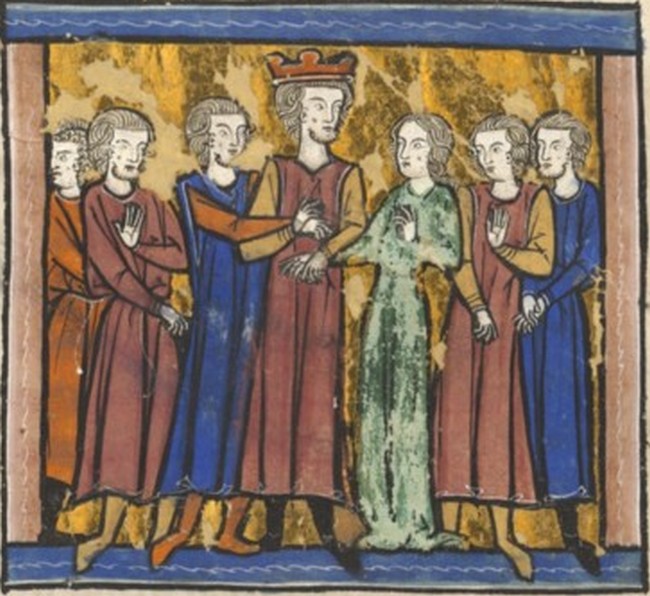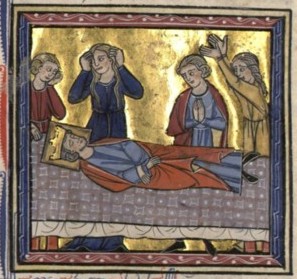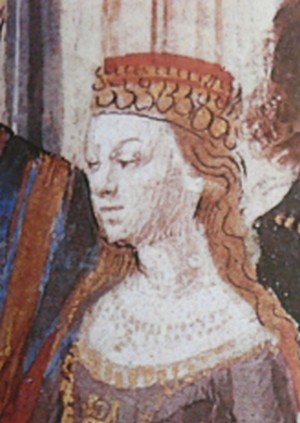|
De Expugnatione Terrae Sanctae Per Saladinum Libellus
The ''Libellus de expugnatione Terrae Sanctae per Saladinum'' (Little Book about the Conquest of the Holy Land by Saladin), also called the ''Chronicon terrae sanctae'' (Chronicle of the Holy Land), is a short anonymous Latin account of the conquests of Saladin (Ṣalāḥ al-Dīn) in the Holy Land between 1186 and 1191. The core of the text was written shortly after the events it describes and then supplemented by the addition of an account of the Third Crusade early in the thirteenth century. This probably took place at Coggeshall Abbey in England. Neither the original author nor the continuator/compiler is known by name. Naming Both of the Latin names for the chronicle—''Libellus de expugnatione Terrae Sanctae per Saladinum'' and ''Chronicon terrae sanctae''—are modern inventions and neither the original title of the work. The former was coined by Edmond Martène and Ursin Durand in 1729. It has been retained by the work's most recent editors, who argue that ''libellus'', wh ... [...More Info...] [...Related Items...] OR: [Wikipedia] [Google] [Baidu] |
Libellus De Expugnatione
A ''libellus'' (plural ''libelli'') in the Roman Empire was any brief document written on individual pages (as opposed to scrolls or tablets), particularly official documents issued by governmental authorities. The term ''libellus'' has particular historical significance for the libelli that were issued during the reign of Emperor Decius to citizens to certify performance of required pagan sacrifices in order to demonstrate loyalty to the authorities of the Roman Empire. During later periods libelli were issued as certificates of indulgence, in which the confessors or martyrs interceded for apostate Christians. Etymology The word ''libellus'' is a Latin diminutive form of the ordinary word ''liber'' (meaning "book"), from which we get the English word ''library''. Literally, it means "little book". Sometimes the word was used to describe what we would call: essays, tracts, pamphlets, or petitions. History During the Decian persecution In the year 250, in an attempt to promote t ... [...More Info...] [...Related Items...] OR: [Wikipedia] [Google] [Baidu] |
Corpus Christi College, Cambridge
Corpus Christi College (full name: "The College of Corpus Christi and the Blessed Virgin Mary", often shortened to "Corpus"), is a constituent college of the University of Cambridge. From the late 14th century through to the early 19th century it was also commonly known as St Benet's College. The college is notable as the only one founded by Cambridge townspeople: it was established in 1352 by the Guild of Corpus Christi and the Guild of the Blessed Virgin Mary, making it the sixth-oldest college in Cambridge. With around 250 undergraduates and 200 postgraduates, it also has the second smallest student body of the traditional colleges of the University, after Peterhouse. The College has traditionally been one of the more academically successful colleges in the University of Cambridge. In the unofficial Tompkins Table, which ranks the colleges by the class of degrees obtained by their undergraduates, in 2012 Corpus was in third position, with 32.4% of its undergraduates achi ... [...More Info...] [...Related Items...] OR: [Wikipedia] [Google] [Baidu] |
Guy Of Lusignan
Guy of Lusignan (c. 1150 – 18 July 1194) was a French Poitevin knight, son of Hugh VIII of Lusignan and as such born of the House of Lusignan. He was king of Jerusalem from 1186 to 1192 by right of marriage to Sibylla of Jerusalem, and King of Cyprus from 1192 to 1194. Having arrived in the Holy Land (where his brother Aimery of Lusignan was already prominent) at an unknown date, Guy was hastily married to Sibylla in 1180 to prevent a political incident within the kingdom. As the health of his brother-in-law, Baldwin IV of Jerusalem, deteriorated, Guy was appointed by Sibylla as regent for his stepson, Baldwin V of Jerusalem. Baldwin IV died in 1185, followed shortly by Baldwin V in 1186, leading to the succession of Sibylla and Guy to the throne. Guy's reign was marked by increased hostilities with the Ayyubids ruled by Saladin, culminating in the Battle of Hattin in July 1187—during which Guy was captured—and the fall of Jerusalem itself three months later. Follo ... [...More Info...] [...Related Items...] OR: [Wikipedia] [Google] [Baidu] |
Sibylla Of Jerusalem
Sibylla ( fro, Sibyl; 1159 – 25 July 1190) was Queen of Jerusalem from 1186 to 1190. She reigned alongside her husband Guy of Lusignan, to whom she was unwaveringly attached despite his unpopularity among the barons of the Kingdom of Jerusalem. Sibylla was the eldest daughter of King Amalric and the only daughter of Agnes of Courtenay. Her father died in 1174, making her heir presumptive to her younger brother, King Baldwin IV. When it became clear that 13-year-old Baldwin had contracted leprosy, the matter of Sibylla's marriage became urgent. The regent, Count Raymond III of Tripoli, arranged for her to marry William Longsword of Montferrat in late 1176, but William left her a pregnant widow, and in possession of the County of Jaffa and Ascalon, in 1177. Shortly after giving birth to a son, Baldwin, Sibylla came to be associated with her brother in public acts, thereby being designated as next in line to the throne. Sibylla's second marriage, to Guy of Lusignan, was arr ... [...More Info...] [...Related Items...] OR: [Wikipedia] [Google] [Baidu] |
Old City (Jerusalem)
The Old City of Jerusalem ( he, הָעִיר הָעַתִּיקָה, translit=ha-ir ha-atiqah; ar, البلدة القديمة, translit=al-Balda al-Qadimah; ) is a walled area in East Jerusalem. The Old City is traditionally divided into four uneven quarters, namely: the Muslim Quarter, the Christian Quarter, the Armenian Quarter, and the Jewish Quarter. A fifth area, the Temple Mount, known to Muslims as the ''Haram al-Sharif'', is home to the Dome of the Rock, Al-Aqsa Mosque and was once the site of two Jewish Temples. The current designations were introduced in the 19th century. The Old City's current walls and city gates were built by the Ottoman Empire from 1535 to 1542 under Suleiman the Magnificent. The Old City is home to several sites of key importance and holiness to the three major Abrahamic religions: the Temple Mount and Western Wall for Judaism, the Church of the Holy Sepulchre for Christianity, and the Dome of the Rock and al-Aqsa Mosque for Islam. ... [...More Info...] [...Related Items...] OR: [Wikipedia] [Google] [Baidu] |
Frederick I, Holy Roman Emperor
Frederick Barbarossa (December 1122 – 10 June 1190), also known as Frederick I (german: link=no, Friedrich I, it, Federico I), was the Holy Roman Emperor from 1155 until his death 35 years later. He was elected King of Germany in Frankfurt on 4 March 1152 and crowned in Aachen on 9 March 1152. He was crowned King of Italy on 24 April 1155 in Pavia and emperor by Pope Adrian IV on 18 June 1155 in Rome. Two years later, the term ' ("holy") first appeared in a document in connection with his empire. He was later formally crowned King of Burgundy, at Arles on 30 June 1178. He was named by the northern Italian cities which he attempted to rule: Barbarossa means "red beard" in Italian; in German, he was known as ', which means "Emperor Redbeard" in English. The prevalence of the Italian nickname, even in later German usage, reflects the centrality of the Italian campaigns to his career. Frederick was by inheritance Duke of Swabia (1147–1152, as Frederick III) before h ... [...More Info...] [...Related Items...] OR: [Wikipedia] [Google] [Baidu] |
Siege Of Acre (1189–1191)
The siege of Acre was the first significant counterattack by Guy of Jerusalem against Saladin, leader of the Muslims in Syria and Egypt. This pivotal siege formed part of what later became known as the Third Crusade. The siege lasted from August 1189 until July 1191, in which time the city's coastal position meant the attacking Latin force were unable to fully invest the city and Saladin was unable to fully relieve it with both sides receiving supplies and resources by sea. Finally, it was a key victory for the Crusaders and a serious setback for Saladin's ambition to destroy the Crusader states. Background Egypt was ruled by the Shi'ite Fatimid dynasty from 969, independent from the Sunni Abbasid rulers in Baghdad and with a rival Shi'ite caliph—that is ''successor'' to the Muslim prophet Mohammad. Governance fell to the caliph's chief administrator called the vizier. From 1121 the system fell into murderous political intrigue and Egypt declined from its previous afflue ... [...More Info...] [...Related Items...] OR: [Wikipedia] [Google] [Baidu] |
Philip II Of France
Philip II (21 August 1165 – 14 July 1223), byname Philip Augustus (french: Philippe Auguste), was King of France from 1180 to 1223. His predecessors had been known as kings of the Franks, but from 1190 onward, Philip became the first French monarch to style himself "King of France" (Latin: ''rex Francie''). The son of King Louis VII and his third wife, Adela of Champagne, he was originally nicknamed ''Dieudonné'' (God-given) because he was a first son and born late in his father's life. Philip was given the epithet "Augustus" by the chronicler Rigord for having extended the crown lands of France so remarkably. After decades of conflicts with the House of Plantagenet, Philip succeeded in putting an end to the Angevin Empire by defeating a coalition of his rivals at the Battle of Bouvines in 1214. This victory would have a lasting impact on western European politics: the authority of the French king became unchallenged, while the English King John was forced by his barons ... [...More Info...] [...Related Items...] OR: [Wikipedia] [Google] [Baidu] |
Richard I Of England
Richard I (8 September 1157 – 6 April 1199) was King of England from 1189 until his death in 1199. He also ruled as Duke of Normandy, Duke of Aquitaine, Aquitaine and Duchy of Gascony, Gascony, Lord of Cyprus, and Count of Poitiers, Counts and dukes of Anjou, Anjou, Count of Maine, Maine, and Count of Nantes, Nantes, and was overlord of Brittany at various times during the same period. He was the third of five sons of King Henry II of England and Eleanor of Aquitaine and seemed unlikely to become king, but all his brothers except the youngest, John, King of England, John, predeceased their father. Richard is known as Richard Cœur de Lion (Norman language, Norman French: ''Le quor de lion'') or Richard the Lionheart because of his reputation as a great military leader and warrior. The troubadour Bertran de Born also called him Richard Oc-e-Non (Occitan language, Occitan for ''Yes and No''), possibly from a reputation for wikt:terseness, terseness. By the age of 16, Rich ... [...More Info...] [...Related Items...] OR: [Wikipedia] [Google] [Baidu] |
Itinerarium Peregrinorum
The ''Itinerarium Regis Ricardi'' (in full, ''Itinerarium Peregrinorum et Gesta Regis Ricardi'') is a Latin prose narrative of the Third Crusade, 1189-1192. The first part of the book concentrates on Saladin's conquests and the early stages of the crusade, with a long description of the expedition of the Emperor Frederick Barbarossa. The rest of the book describes King Richard I of England's participation in the crusade. The ''Itinerarium '' was formerly attributed to Geoffrey de Vinsauf, and was said to be a first-hand narrative. In fact, it was apparently compiled by Richard de Templo, a canon of Holy Trinity, London, in the early 1220s, on the basis of at least two lost contemporary memoirs. The first part is similar to the so-called ''Latin Continuation of William of Tyre'', which seems to be a reworked version of the ''Itinerarium ''. The second part, in particular, is closely related to an Anglo-Norman poem on the same subject, Ambroise's ''L'Estoire de la Guerre Sainte''. I ... [...More Info...] [...Related Items...] OR: [Wikipedia] [Google] [Baidu] |
List Of Christian Holy Places In The Holy Land
The list of Christian holy places in the Holy Land outlines sites within cities located in the Holy Land that are regarded as having a special religious significance to Christians, usually by association with Jesus or other persons mentioned in the Bible. The identification of the Christian holy sites became of increased importance especially from around the time of Constantine the Great of the Roman Empire. Interest was also strong during Emperor Charlemagne, as was also the case during the Crusades, when Christian pilgrims often sought out ''holy places'' in the Outremer, especially in early 12th century immediately after the capture of Jerusalem.Sean Martin, ''The Knights Templar: The History & Myths of the Legendary Military Order'', 2005. The search for the Christian holy places was the foundation of 19th-century European Biblical archaeology in Ottoman Syria and later in the British Mandate Palestine. Definition The primary holy places are connected to the main events i ... [...More Info...] [...Related Items...] OR: [Wikipedia] [Google] [Baidu] |
Siege Of Jerusalem (1187)
The siege of Jerusalem lasted from 20 September to 2 October 1187, when Balian of Ibelin surrendered the city to Saladin. Earlier that summer, Saladin had defeated the kingdom's army and conquered several cities. Balian was charged with organizing a defense. The city was full of refugees but had few soldiers. Despite this fact the defenders managed to repulse several attempts by Saladin's army to take the city by storm. Balian bargained with Saladin to buy safe passage for many, and the city was peacefully surrendered with limited bloodshed. Though Jerusalem fell, it was not the end of the Kingdom of Jerusalem, as the capital shifted first to Tyre and later to Acre after the Third Crusade. Latin Christians responded in 1189 by launching the Third Crusade led by Richard the Lionheart, Philip Augustus, and Frederick Barbarossa separately. In Jerusalem, Saladin restored Muslim holy sites and generally showed tolerance towards Christians; he allowed Orthodox and Eastern Christ ... [...More Info...] [...Related Items...] OR: [Wikipedia] [Google] [Baidu] |







